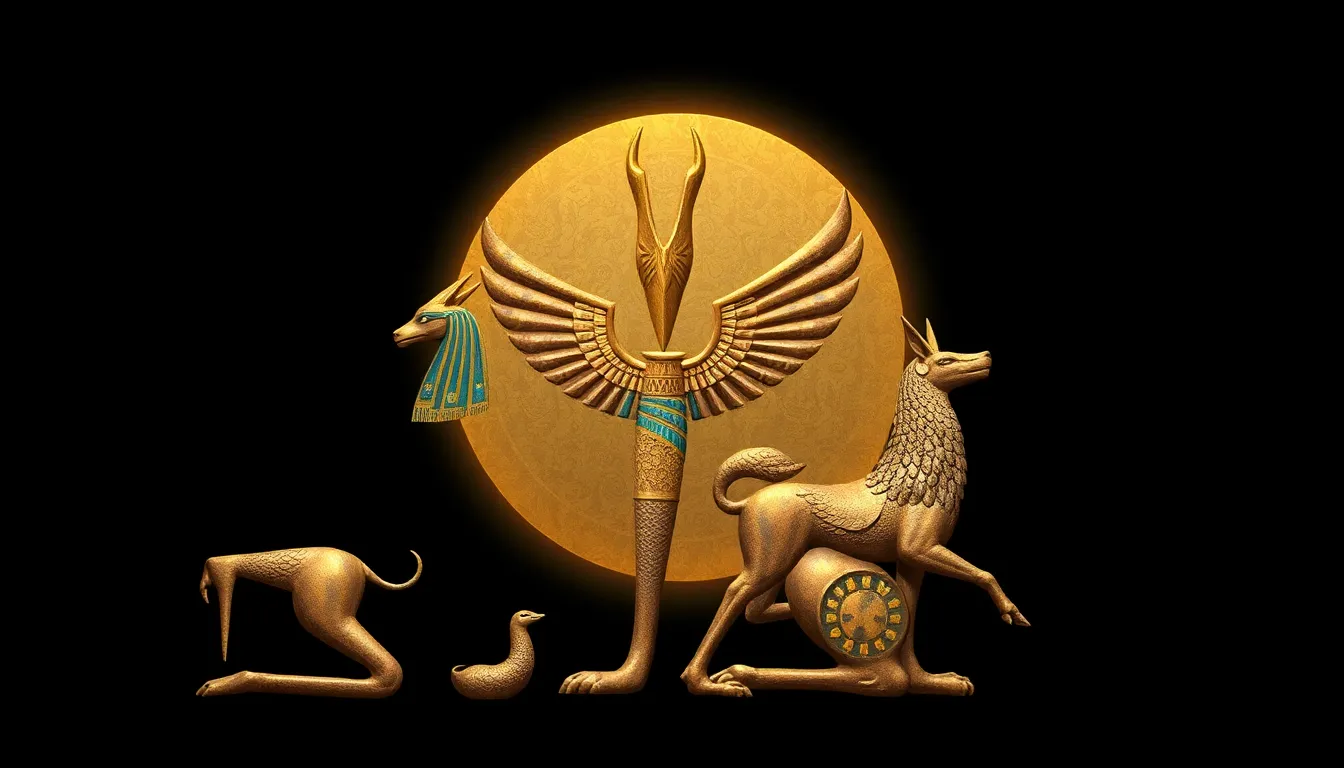The Sacred Animals: Symbols of the Egyptian Gods
I. Introduction
The ancient Egyptian religion is one of the most fascinating belief systems in history, characterized by a complex pantheon of gods and goddesses, rituals, and cultural practices. Central to this religion was the reverence for animals, which were often seen as manifestations of divine qualities and attributes. This article aims to explore the sacred animals of ancient Egypt, highlighting their significance as symbols of the gods and their roles within the broader context of Egyptian mythology and culture.
II. The Role of Animals in Ancient Egyptian Beliefs
Animals held a unique place in ancient Egyptian beliefs, serving as representations of divine qualities that the gods embodied. The Egyptians believed in the concept of animal deification, where certain animals were revered and worshipped as sacred beings. This reverence extended into everyday life, where animals were not only companions but also symbols of protection and prosperity.
- Animals as representations of divine qualities: Each sacred animal was believed to embody specific traits that reflected the nature of the gods they represented.
- The concept of animal deification: Many animals were worshipped directly, with temples and rituals dedicated to them.
- Everyday life and reverence for animals: Animals were integrated into daily practices, influencing agricultural, social, and economic aspects of life.
III. Major Sacred Animals and Their Associated Gods
A. The Cat: Symbol of Bastet
Bastet, the goddess of home, fertility, and domesticity, is often depicted as a lioness or as a woman with the head of a lioness or domestic cat. Cats were revered in ancient Egypt for their grace and hunting prowess.
- Characteristics of Bastet and her attributes: Bastet was seen as a protector of the household and children, embodying nurturing and protective qualities.
- Cultural significance of cats in ancient Egypt: Killing a cat, even accidentally, was punishable by death, highlighting their revered status.
B. The Falcon: Symbol of Horus
Horus, one of the most significant deities in Egyptian mythology, was often represented as a falcon or a man with the head of a falcon. He was associated with the sky and kingship.
- Horus’s role as a sky god and protector: Horus was considered the protector of the pharaoh and the embodiment of divine kingship.
- The falcon’s representation of kingship and power: The falcon’s ability to soar high in the sky symbolized the pharaoh’s connection to the divine.
C. The Ibis: Symbol of Thoth
Thoth, the god of wisdom, writing, and knowledge, was symbolized by the ibis, a bird known for its intelligence and unique appearance.
- Thoth’s association with wisdom and writing: Thoth was credited with inventing writing and was often depicted recording the deeds of the dead.
- The significance of the ibis in Egyptian society: The ibis was admired for its role in agriculture, as it helped control pests and was associated with the annual flooding of the Nile.
IV. Animal Cults and Worship Practices
Animal worship was a significant aspect of ancient Egyptian religion, with various temples dedicated to sacred animals. These temples served as centers for rituals and festivals celebrating animal deities.
- Temples dedicated to sacred animals: Notable temples included the Bubastis Temple for Bastet and the Ibis Temple for Thoth.
- Rituals and festivals celebrating animal deities: Festivals often included processions, offerings, and feasting, which were essential to the community’s spiritual life.
- The role of priests and priestesses in animal worship: Priests and priestesses managed the temples, conducting ceremonies and caring for the sacred animals.
V. The Symbolism of Other Sacred Animals
In addition to the aforementioned sacred animals, several others played significant roles in Egyptian mythology.
- The Crocodile: Symbol of Sobek: Sobek, the god of the Nile, was often depicted as a crocodile or a man with a crocodile head, symbolizing strength and protection.
- The Bull: Symbol of Apis and Hathor: The Apis bull was worshipped as a manifestation of the fertility god Ptah and was considered a symbol of strength and prosperity.
- The Jackal: Symbol of Anubis: Anubis, the god of mummification and the afterlife, was represented as a jackal, highlighting his role in protecting the dead.
VI. The Legacy of Sacred Animals in Egyptian Art and Literature
The sacred animals of ancient Egypt have left a lasting legacy in art and literature, influencing how these creatures are perceived even today.
- Depictions of animals in hieroglyphics and tomb paintings: Sacred animals were commonly depicted in hieroglyphs and tomb art, often symbolizing the attributes of the gods.
- The influence of sacred animals on literature and mythology: Stories and myths often revolved around these animals, emphasizing their divine connections.
- Modern interpretations and representations in popular culture: The imagery of sacred animals continues to inspire modern art, literature, and media.
VII. The Impact of Sacred Animals on Modern Understanding of Ancient Egypt
The study of sacred animals provides invaluable insights into ancient Egyptian society and its cultural practices.
- Insights into ancient Egyptian society through animal worship: Understanding the role of animals in religious practices helps historians comprehend societal values.
- The relevance of animal symbolism in contemporary discussions of culture: The symbolism associated with these animals resonates in modern discussions about the relationship between humans and nature.
- Preservation of animal-related artifacts and archaeology: Archaeological discoveries continue to reveal the profound significance of sacred animals in ancient Egyptian culture.
VIII. Conclusion
In conclusion, sacred animals played a pivotal role in ancient Egyptian mythology, serving as symbols of the gods and reflecting the culture’s values and beliefs. The reverence for these animals underscores the intricate relationship between humans and the divine in ancient Egyptian society. Today, the legacy of these sacred animals continues to resonate, enriching our understanding of ancient beliefs and practices, and reminding us of the enduring connection between culture and nature.




